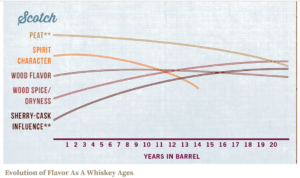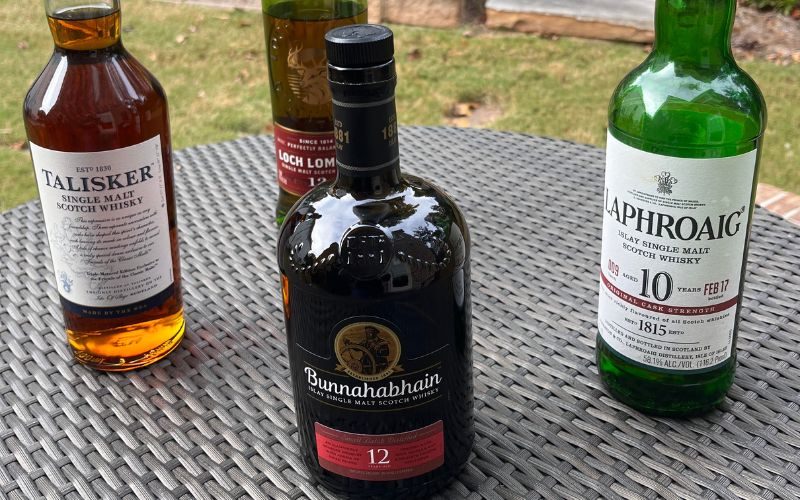Peat is a soft organic material made from partially decayed vegetation that accumulated over centuries. When dead vegetation builds in soils that hold water, the lack of oxygen creates the necessary conditions to delay the decomposition of this matter, forming what is known as peat.
In Scotland, distilleries burned peat as fuel to dry the grain, and due to the lack of alternatives, peated whiskeys were the industry standard. The railway allowed the introduction of coal to Speyside and the Lowlands, giving distilleries in these regions a chance to experiment with other sources that burn evenly and with less smoke. However, distilleries in Islay and Orkney continued with the traditional peated whiskies to later incorporate different proportions of peated/unpeated barley to expand the range of flavors. Nowadays, most distilleries contract the purchase of peated malt and use a small proportion from their malting floors. That is the case of The Balvenie and many others.
In the malting process, specifically in the kilning, germination is halted by blowing peated smoke from the kiln (located on the bottom floor) to the upper malting floor to create aromas of tar, smoke, ash, and iodine from organic compounds called phenols. Kilning can take up to 18 hours.
Not all peat is created equal. Peat close to the sea has iodine and medicinal flavors due to the influence of saltwater in the decomposed vegetal matter. Peat from the mainland has flavors of smoke, heather, and barbeque because it is rich in decayed wood matter. The moisture content inside the peat also plays a role in shaping the flavor profile.
Peat content in the malt is measured in PPM (parts per million) to determine the phenol content of the malted barley after kilning and before being used in the rest of the whisky-making process, but be careful not to think that PPM is the main indicator of taste because we all know that phenols content can decrease due to many factors, including:
- The duration of the fermentation. Longer fermentations create fruit flavors that mask the peat flavor.
- The shape of the stills. Taller still helps remove the phenols.
- Distillation cuts. A lower cut point reduces the amount of phenols passed to the condenser. Phenols in malt vs. phenols in the final spirit is about 3:1 (A lot of smoke flavor is left behind when you reach the bottling stage)
- Barrel aging and Type. Here is one of my favorite graphs from Lew Bryson about aging Scotch Whisky to illustrate how barrel aging influences the peat flavor. Also, a first still cask (i.e., ex-Oloroso sherry) can balance the phenols and create a delicious malt.
- Blending. Distilleries can adjust the flavor by blending heavily peated whiskies with lightly peated ones and playing with proportions and still claim the distillery used 100 PPM peated barley on the label.

Lew Bryson’s Aging Graph
To think that a 150 PPM whisky tastes ten times more peaty than a 15 PPM whisky is clearly not the right way to think about it. I almost find it funny when brands and enthusiasts argue and claim they have tasted the peatiest whisky. Does it really matter? Honestly, I ask myself: Is the whisky balanced? Do I like the overall flavor profile? Does the malt retain the distillery spirit style? It is that simple.
Here are some single malt suggestions based on smoke or peat intensity on the palate, not PPM.
Light: Peat is in the background and not designed to be the main draw of the experience.
- Bunnahabhain 12 Year Old
- Knockando 12 Year Old
- Glenkinnchie 12 Year Old
- The Glenlivet 12 Year Old
Moderate: The peat flavor can be easily identified but does not overwhelm.
- Highland Park 12 Year Old
- Dalwhinnie 15 Year Old
- The Classic Laddie
- Loch Lomond 12 Year Old
Medium-Heavy: Smoke and peat are intense and bold.
- Ardbeg 10 Year Old
- Talisker 10 Year Old
- Laphroaig Quater Cask
- Lagavulin Offerman Edition
I hope you enjoyed this note about peated malts. Check pictures and videos of peated whiskies on my Instagram channel. Slainte!





